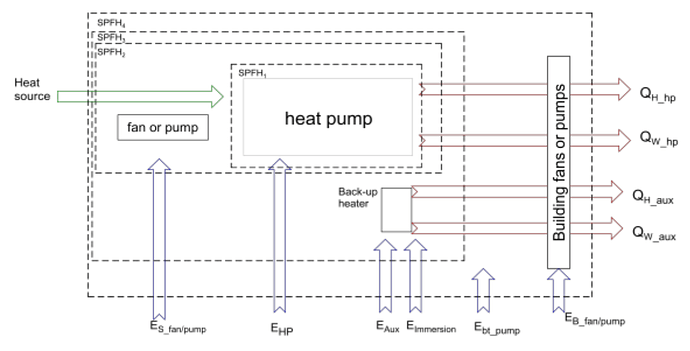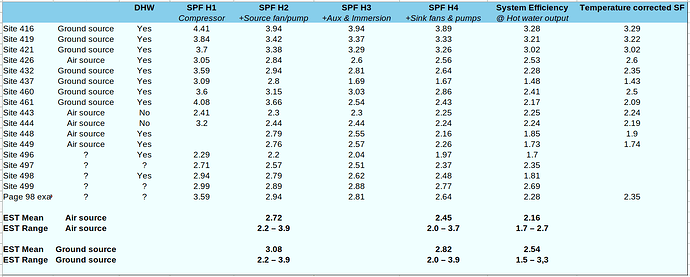I thought it might be interesting to compare our results so far with those from the Energy Saving Trust ‘The Heat is On’ Phase 2 Trials. Their detailed analysis is available here: https://assets.publishing.service.gov.uk/government/uploads/system/uploads/attachment_data/file/225825/analysis_data_second_phase_est_heat_pump_field_trials.pdf
One of the things that their work and report is very good at is defining and collecting data on different system boundaries. It’s something I’ve been aware of for some time having read their report years ago but it’s something we haven’t been very clear on yet on heatpumpmonitor.org.
There’s a useful diagram in the report that defines the H1,H2,H3 & H4 boundary (the accompanying discussion is also useful and worth reading). There’s also a further system efficiency boundary that measures the heat output at the domestic hot water outlets rather than the heat input to the tank.
Trawling through that report, I extracted the following table of values for the subset of heat pumps they discuss in the report. Does anyone know if the original data can be downloaded somewhere in full?
The table shows how the SPF figures change with different system boundaries and the results are quite interesting! The drops from H1 to H2 for some of the ground source systems and difference between H1 and H4 can be surprisingly high!
They also share breakdowns of the electricity consumption of some of the sites:
I’ve been monitoring my own system to the SPF H4 boundary with the results including the immersion heater used for legionella protection listed on my monthly summary blog page e.g: https://trystanlea.org.uk/heatpump2021. The results on https://emoncms.org/midterrace/ include everything except the immersion heater - but then I so seldomly use the immersion heater that there’s not that much difference, in 2021 the difference was 4.06 without the immersion and 4.04 with the immersion (correct H4 boundary). Still, I really need to add the immersion heater as a feed option in the My Heatpump app.
Still… my SPF H4 is significantly better than all air source and ground source heat pumps on the subset above ![]() and most of the air source heat pumps on heatpumpmonitor.org have better, if not significantly better SPF H2 values than the SPF H2 values in the trial.
and most of the air source heat pumps on heatpumpmonitor.org have better, if not significantly better SPF H2 values than the SPF H2 values in the trial.
It would be great to be clear about the system boundaries of the data on heatpumpmonitor.org.
A slightly tricky one is how to deal with solar PV divert to an immersion heater? Should that be included in the system boundary of the heat pump? It seems like an unfair penalty for something that makes total sense economically especially if you dont have a battery to be used as a buffer for running the heat pump to do DHW in the summer…


